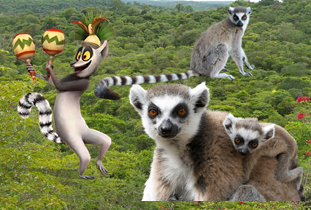Ring Tailed Lemur
- for social goods
- Feb 25, 2023
- 2 min read
Updated: May 3, 2024
The Ring-Tailed Lemur, scientifically known as Lemur catta, inhabits the rainforests of southwestern Madagascar. Its closest relatives include the Red Ruffed Lemur, Bamboo Lemur, Fossa, Galagos, Lorises, and Komodo Dragon, which all share similar characteristics such as claws, live birth, amniotic eggs, and fur. The amino acid sequencing between these species and related features shows that they are ancestors of lemurs.
Lemurs have strong gripping feet and hands that help them navigate through rocks and branches and avoid predators. Their dexterous big thumbs and toes are perfect for living in and climbing trees, and the long hair on their palms and soles increases friction, preventing them from slipping or falling. They also have scent glands on their wrists, chests, and genital regions that aid in marking territory and finding mates. Their large tails, adorned with beautiful black and white patterns, are longer than their bodies and help with balance and communication as they roam in tall grass or woods.
Male lemurs have more developed scent glands than females, which they use as tools to fight for females during the breeding season and as weapons to defend against enemies. During the rainy season, when food is abundant, they store a large number of nutrients in their tails, which they consume during dry seasons when food sources are scarce. Lemurs are diverse eaters and consume almost everything they can find. They have an exceptional sense of smell with their wet noses, which helps them find food like leaves and fruits from their scent.
Madagascar and Africa became farther apart over time, causing the ancestors of lemurs to be separated from their mainland counterparts, who slowly withered and were squeezed out by the emerging high-intelligence apes. The lemurs on Madagascar thrived because they had no natural predators and could lower their metabolism and become dormant while living off fat reserves. They live in social groups called troops, consisting of 3-25 individuals, which increases their chances of survival and reproduction. They sleep in groups to keep warm and provide protection against predators. However, all lemur species are now in critical danger due to deforestation caused by human activities, such as slash-and-burn farming. Madagascar's original forests have been mostly destroyed, with only 10% to 20% remaining.
The last chance of survival for lemurs depends on rainforest conservation projects and donations from tourists, such as the BioCarbon Fund of the Malagasy government and Conservation International, and the Anja Community Reserve's efforts to conserve lemur populations in Madagascar. Even outside of Madagascar, support for lemurs is being extended. In the United States, the campus of Duke University in Durham, NC, plays a significant role as it houses the world's largest and most diverse population of lemurs outside of their native habitat.
By collaborating on a global scale and raising awareness, we can collectively ensure a hopeful future for these endangered creatures and preserve their precious ecosystems.



